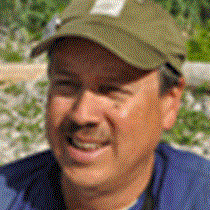The Master Builder chose for a tool not the earthquake nor lightning to rend and split asunder, not the stormy torrent nor eroding rain, but the tender snowflowers, noiselessly falling through unnumbered seasons.
—John Muir, describing the power of glaciers
Early in the morning, the National Geographic Sea Bird entered Tracy Arm by crossing the shallow terminal moraine that was produced long ago when the glacier was at its furthest extent. The presence of icebergs was an indication that we were in the vicinity of tidewater glaciers that calve ice into the sea. We were cruising up a narrow and spectacular glacially-carved fjord that averages only a mile in width along its entire 26-mile length. In the upper part of the fjord are two tidewater glaciers (Sawyer and South Sawyer Glaciers), which were joined as recently as 1880.
Soon after breakfast, inflatable boats were launched that allowed us to work our way carefully through the icebergs to view the face of South Sawyer Glacier, where we spent some time cruising to observe the texture and patterns in the ice. A light rain fell as we examined the evidence of glaciation such as glacial striations and glacial polish on the steep granite walls. Even the green color of the water was caused by finely-ground glacial rock flour. We were able to get close enough to some of the icebergs to see recently-born harbor seal pups and their mothers. In comparing pictures of the glacier taken just a few years ago, it was obvious that the glacier had retreated dramatically.
Once back on board, the National Geographic Sea Bird slowly maneuvered through the icebergs and began our journey out through the fjord. The clear blue color of many of the icebergs made them look like precious gemstones, and some icebergs even appeared to have been sculpted at the hand of an expert ice-carver. The sheer, glacially-polished cliffs appeared luminous in the sunlight as were the presence of bowl-shaped cirques, U-shaped valleys, and hanging valleys.
After lunch, the ship maneuvered into the Hole-in-the-Wall Waterfall so that we could get a close-up view of its unique features. The amount of water spilling down the granite cliff was amazing. Soon thereafter, we anchored in Williams Cove, which is an inlet near the entrance to Tracy Arm.
The afternoon activities in Williams Cove included a choice of expedition landing craft cruising, kayaking, and hiking. For the cruisers and paddlers, the wide bay was perfect for exploring the bay, waterfalls, and sea caves, which beckoned us to explore along the shore. Meanwhile, those on the hikes were busy following bear tracks or forging their own trails in the insect-laden forest. The explorations were really a taste of what Alaska is all about—discovering this vast wilderness for ourselves.
After our evening Recap we had another superb meal as the sun began to shine through the clouds. As if on cue, humpback whales were sighted as we began cruising south towards our next day’s adventure in this great land.







